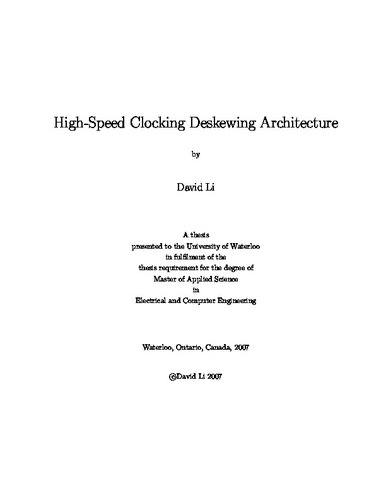| dc.description.abstract | As the CMOS technology continues to scale into the deep sub-micron regime, the demand
for higher frequencies and higher levels of integration poses a significant challenge for the clock generation and distribution design of microprocessors. Hence, skew optimization schemes are necessary to limit clock inaccuracies to a small fraction of the clock period. In this thesis, a crude deskew buffer (CDB) is designed to facilitate an adaptive deskewing scheme that reduces the clock skew in an ASIC clock network under manufacturing process,
supply voltage, and temperature (PVT)variations. The crude deskew buffer adopts a DLL structure and functions on a 1GHz nominal clock frequency with an operating frequency range of 800MHz to 1.2GHz. An approximate 91.6ps phase resolution is achieved for all simulation conditions including various process corners and temperature variation. When the crude deskew buffer is applied to seven ASIC clock networks with each under various
PVT variations, a maximum of 67.1% reduction in absolute maximum clock skew has been achieved. Furthermore, the maximum phase difference between all the clock signals in the seven networks have been reduced from 957.1ps to 311.9ps, a reduction of 67.4%. Overall, the CDB serves two important purposes in the proposed deskewing methodology: reducing the absolute maximum clock skew and synchronizes all the clock signals to a certain limit for the fine deskewing scheme. By generating various clock phases, the CDB can also be potentially useful in high speed debugging and testing where the clock duty cycle can be adjusted accordingly. Various positive and negative duty cycle values can be generated based on the phase resolution and the number of clock phases being “hot swapped”. For a
500ps duty cycle, the following values can be achieved for both the positive and negative duty cycle: 224ps, 316ps, 408ps, 592ps, 684ps, and 776ps. | en |

